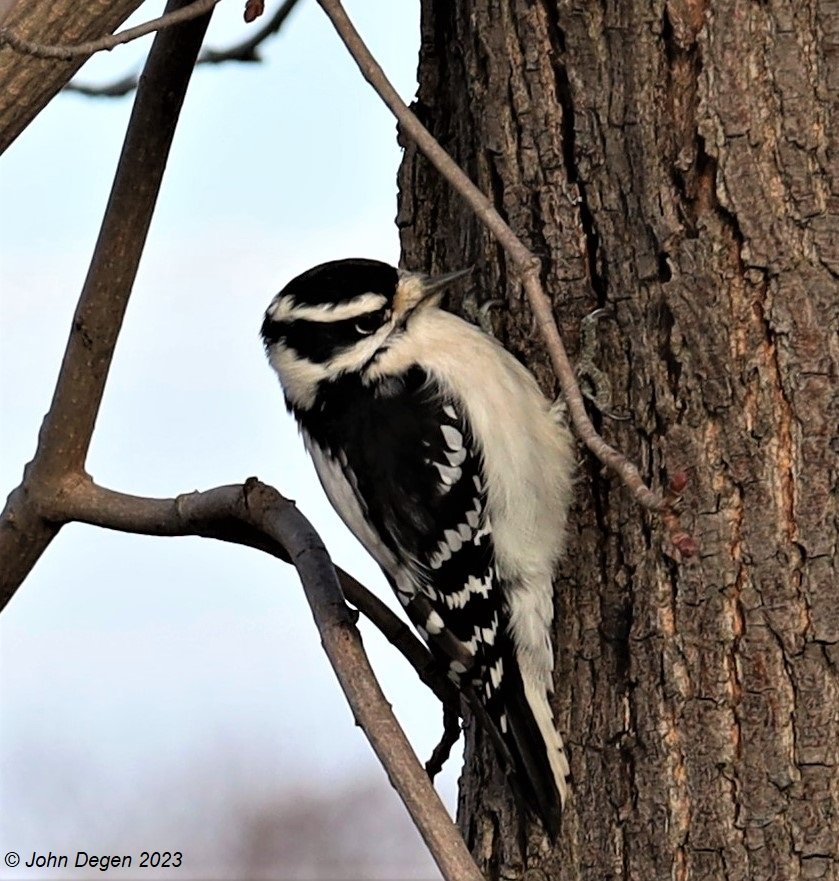I’m not an ornithologist, but I play one on the internet. And I’m curious. As I stand (lately, freezing), waiting for a bird to come just a little bit closer, I wonder things.
1. Can birds freeze to death? Come to think of it, that’s probably projection.
2. Why are owls afraid of me when I’m clearly terrified of them and their face-grabbing talons?
3. And a big one I’ve often returned to — why don’t I find dead woodpeckers all the time, expired from the head trauma they inflict upon themselves just to get a meal?
So I went to university; got my degree in ornithology; partnered with scientists from around the world…
Just kidding. I googled “do woodpeckers get headaches?” The answer may surprise you. We don’t know… because woodpeckers can’t talk to us, and are not able to grasp the Advil bottle with their claws tightly enough to open it. But it’s unlikely they suffer too much from all that wood pecking and head banging they do.
Because, in laypersons’ terms, woodpeckers wear helmets. In fact, they wear one of the most sophisticated and scientifically complex helmets ever devised. Their helmet… starts at their tongue, and is an integral part of their skull structure. Attached to a woodpecker’s impressively long tongue (great for nabbing insects deep in bark, I imagine) is a bone called the hyoid.
Illustration of a woodpecker skull, hyoid bone, and tongue, courtesy Wikimedia
Now, if you’re anything like me, you hear hyoid and you go immediately to CSI and other murdery television shows. In humans, the hyoid bone is in the throat, and is almost always broken in instances of manual strangulation. So, the CSI rule is “if the hyoid is broked, the victim was choked.”
Woodpecker hyoids also originate around the throat and attach to the tongue, but then they wrap around the skull in an elegant, curving v-shape, and act a bit like a shock-absorber for that delicate little brain that knows where all the good bugs are.
According to a couple of scientific papers I’ve been reading (I’m not JUST a Googler, you know; I actually do the reading), there is still no consensus on how exactly woodpeckers avoid brain trauma. Almost certainly the hyoid helmet helps, but the beak shape, and it’s attachments to the rest of the body probably help as well. If the lower beak takes most of the impact, the stress is likely transferred down the neck to the rest of the body, also sparing the brain.
Downy woodpecker on a suet ball in front of Gerry and Pauline’s house.
My buddies Pauline and Gerry up here in Northern Ontario hang balls of suet and seed from the tree out front of their house. Their visitors are mostly woodpeckers of all size and type. Must be a nice break for a woodpecker to grab a meal without having to clear away a mass of bark first. Gerry and Pauline are the real heroes of this story.
Further reading:
https://journals.plos.org/plosone/article?id=10.1371/journal.pone.0026490
https://askabiologist.asu.edu/plosable/woodpeckers
https://letstalkscience.ca/educational-resources/stem-in-context/do-woodpeckers-get-concussions







